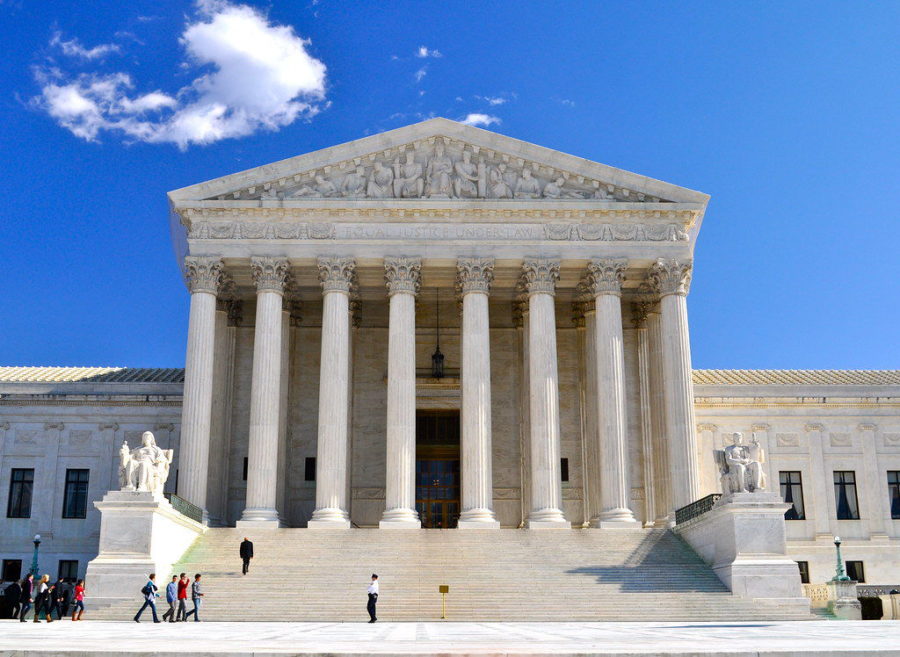Round three: The Affordable Care Act is argued at the Supreme Court
The United States Supreme Court is the highest court in the federal judiciary and is currently composed of nine justices.
November 11, 2020
The Affordable Care Act (ACA) made it back to the Supreme Court yet again as the highest court heard arguments regarding its constitutionality Tuesday. Key justices appeared in support of possibly upholding the act.
The ACA is now being challenged for the third time, and President Donald Trump has promised on multiple occasions to repeal it and replace it. In 2017, Congress zeroed out the mandate, rendering it toothless. Republicans argue the ACA must be struck down because the mandate is interwoven into the rest of the law.
During the arguments, two of the six conservative justices appeared to question Republican efforts to overturn the ACA in terms of severability.
In law, severability is when a term of legislation is deemed illegal or unenforceable, but the remainder of the law should still stand. Both Chief Justice John Roberts and Justice Brett Kavanaugh indicated striking down the individual mandate did not require the rest of the ACA to be struck down as well.
“It does seem fairly clear that the proper remedy would be to sever the mandate provision and leave the rest of the law in place,” Kavanaugh said during the recent arguments.
The concept of an individual mandate derives from health care reform created by Republicans in the 1990s. This market-based approach contrasts single-payer health care in which essential health care costs are covered by a single public system.
Single-payer health care is a kind of universal health care that costs for residents covered by a single public system — health care is paid for by a single public authority, not private or a mix of both.
“[Democrats] opted to use this individual mandate approach because it kept the private insurance companies exclusively in the game of delivering insurance, and they had thought because Republicans had proposed this solution, they would go for this,” said Dirk Deam, Iowa State teaching professor of political science.
All 178 Republicans voted against the bill and introduced legislation to repeal the bill the day following the approval. Additionally, they have made it a part of their agenda since and multiple lawsuits have followed. The Republicans’ approval for the act lingers around 11 percent, opposed to the 94 percent of Democrats in support of it.
“What Congress is doing with the ACA is regulating the private insurance industry, which is commerce,” Deam said. “By definition, that industry is interstate in character, and the commerce clause refers to commerce among the state. So it seems to be squarely in the realm of the commerce clause.”
In 2012, conservatives argued Congress’ commerce authority did not cover mandating an individual’s right to forgo health insurance. Roberts played a key role in saving the ACA by arguing on the grounds that it was a tax.
“In the original case, the individual mandate was necessary to increase the insurance pool because without that insurance pool, insurance companies won’t be able to ensure people with preexisting conditions and so it can not be … severed from Obamacare,” Deam said. “You strike down individual mandates, you strike down Obamacare, and people lose their insurance.”
Deam said after the ACA went into effect, it turned out the mandate wasn’t as necessary as it was originally thought to be. Now, the lack of teeth in the ACA is the core basis of Republicans’ argument against the act seven years later.
Mack Shelley, Iowa State professor and chairman of political science, said this case and others in the past are to follow up on Republicans’ attempts to repeal the ACA through Congress.
“Despite many failed efforts, and just one part in the 2017 tax bill, Republicans are trying another avenue to completely eliminate Obama’s Affordable Care Act,” Shelley said.
Since the ACA passed in 2010, public approval has shifted and is now supported by a majority of Americans at 52 percent as of February 2020, according to Gallup.
Shelley said approval for the ACA improved because of major provisions, such as coverage of preexisting conditions. Around 130 million Americans have some kind of preexisting condition. This can result in the lack of coverage in part of additive expenses, so people can’t receive the care they need.
The ACA also ensures anyone under the age of 26 can receive coverage under their parent’s insurance plan. John Paschen, chairman of the Story County Board of Health, said the ACA has decreased the number of children who are uninsured.
“The risk of that being taken away is a direct danger to our children’s health,” Paschen said. “… The importance of our future is children.”
Shelley said public opinion polls show a minority of people in opposition to these two provisions, but it is in the design of the court that is supposed to be insulated from public opinion and democratic forces.
Deam said this isn’t always the case. The Roosevelt administration attempted to pass an act of Congress to handle the Great Depression but faced a hostile Supreme Court in the process, striking those measures down.
After winning his reelection, President Franklin Roosevelt proposed a court-packing plan to add additional justices to balance the Supreme Court. The attitude of the Court changed because of this, so increasing the number of justices could be an option for the Biden administration if they, too, were to face a hostile court.
Deam said for the Courts to not consider these factors may result in the public viewing them as a barrier to the national good.
“They are insulated by the Constitution, but they’re not insulated in practice, and in reality, they know the politics of the situation, and I suspect this will have some influence on their decision,” Deam said.
Insurance expenses would likely rise if the health insurance field was completely privatized. Shelley said it is hard to find any other major country that doesn’t have some kind of national health care system.
Paschen said the ACA is about access to medical care, and if people think they can not pay for the needed medical attention, they may not seek help until they are very sick.
“That has always been the issue of people who don’t have health care, they can get health care in place, but because they have no resources, they are hesitant,” Paschen said.
Shelley said it is hard to think of the worst time to cut people off to relatively easier access to health care as the country continues to battle the pandemic.
“I think, almost to preserve the integrity of the court, it would seem like a really inappropriate move to eliminate health care coverage for so many people at a time when there is just this crying need for a health care system that is well funded,” Shelley said.







